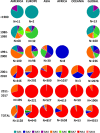Respiratory syncytial virus A genotype classification based on systematic intergenotypic and intragenotypic sequence analysis
- PMID: 31882808
- PMCID: PMC6934736
- DOI: 10.1038/s41598-019-56552-2
Respiratory syncytial virus A genotype classification based on systematic intergenotypic and intragenotypic sequence analysis
Abstract
Respiratory syncytial virus (RSV), a leading cause of lower respiratory tract infections, is classified in two major groups (A and B) with multiple genotypes within them. Continuous changes in spatiotemporal distribution of RSV genotypes have been recorded since the identification of this virus. However, there are no established criteria for genotype definition, which affects the understanding of viral evolution, immunity, and development of vaccines. We conducted a phylogenetic analysis of 4,353 RSV-A G gene ectodomain sequences, and used 1,103 complete genome sequences to analyze the totallity of RSV-A genes. Intra- and intergenotype p-distance analysis and identification of molecular markers associated to specific genotypes were performed. Our results indicate that previously reported genotypes can be classified into nine distinct genotypes: GA1-GA7, SAA1, and NA1. We propose the analysis of the G gene ectodomain with a wide set of reference sequences of all genotypes for an accurate genotype identification.
Conflict of interest statement
J.C.M.E., A.C.G., S.B.S., C.D.R.E. and G.G.L. declare that there are no competing interests regarding the publication of this manuscript. D.E.N. has participated as a member of the speakers’ bureau of AbbVie and speakers’ bureau and advisory board for Sanofi Pasteur.
Figures








References
MeSH terms
LinkOut - more resources
Full Text Sources
Medical
Miscellaneous

